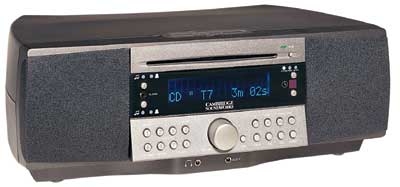Radio's Back on the Table Page 3
Cambridge SoundWorks CD 740With its three-driver stereo speaker system, slot-loading CD player, and front and back auxiliary inputs, the CD 740 is less like a table radio than an extremely compact music system - and a pretty sophisticated one. Its FM tuner boasts RDS (Radio Data System) capability, which lets the CD 740 display station call letters and RDS text messages - like song titles - from participating broadcasters (a good idea that's never really caught on in this country). And its CD section supports both CD Text and MP3 playback with text titles. All these features do add a layer of complexity. 
The CD 740 has more than 20 buttons on its front panel, plus a volume knob that doubles as a scroll wheel for a menu system that controls some secondary functions, such as tone adjustment, loudness compensation, and mono/stereo selection. Sensible arrangement makes the controls relatively easy to learn and use, however. To the right of the knob are the transport, tuning, source-selection, and power buttons. On the left are eight buttons for storing and recalling as many as 24 station presets (two FM banks and one AM), some of which perform other functions for CD playback, which begins automatically when a disc is inserted. Flanking the large display are four buttons for operating the clock and two alarms. And on top of the case is a large bar that serves as a snooze control in alarm mode and a mute button during normal listening. Nearly all of the controls are duplicated on a credit-card-size remote (not shown). Both an AM loop and an external wire FM antenna are supplied. AM reception was good on local stations. On the FM band, the radio received 21 stations cleanly in stereo using just its built-in power-line antenna, 22 with the external wire antenna, and 32 with the attic antenna. (That's actually better than the reference tuner's stereo mark of 30 stations from the attic antenna.) And the CD 740 pulled in stations on adjacent channels without interference. Regardless of source, sound quality was best with loudness compensation engaged and the bass turned down slightly. Both CDs and FM had excellent bass and treble, accompanied by a smoothness and clarity that put many larger, costlier shelf systems to shame. AM reproduction was clear, though with a balance that favored warmth over sparkle.
Despite its profusion of buttons, the CD 740 was easy to operate. Having mono/ stereo selection buried in the setup menu was occasionally annoying, and I would have liked to be able to mute the interstation noise while tuning - minor points. You could spend twice as much (or more) on a conventional stereo minisystem and come away far less satisfied.





























































